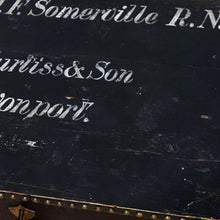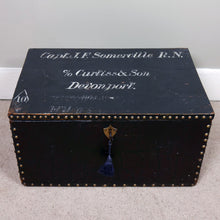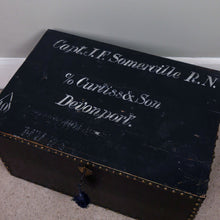Captain Somerville RN Sea Chest, 1925
- Regular price
- £685
- Sale price
- £685
- Regular price
-
- Unit price
- /per
Adding product to your cart
Canvas covered wooden chest belonging to Captain James Fownes Somerville RN. Of midshipman's type reinforced with steel bands and corners. Iron drop handles at either end. Painted black and named to the front ‘Captain J.F. Somerville RN / c/o Curtiss & Son / Devonport’, for James Fownes Somerville - a signals specialist who later became the Second World War fighting admiral, who after the French armistice with Nazi Germany, was given the Gibraltar based Force H by Winston Churchill and charged with neutralizing the main element of the French battle fleet, then at Mers El Kébir in Algeria. After he had destroyed the French fleet, he played an important role in the pursuit and sinking of the German battleship Bismarck, and later in taking the fight to the Japanese in the Far East.
Admiral of the Fleet Sir James Somerville (1882-1949) GCB, GBE, DSO entered the Royal Navy in 1898. During the First World War (1914-1918) he was fleet wireless officer for the Mediterranean Fleet, and was awarded the DSO his role in supporting troops on the Gallipoli Peninsula. In January 1917 he transferred to the battleship HMS King George V in the Grand Fleet and then joined the signals school at Portsmouth at the end of the year. Promoted Captain in 1921. He served as the Director of the Admiralty's Signal Department from 1925 to 1927, and was twice Flag Captain to Sir John Kelly. He served as a Naval Instructor at the Imperial Defence College from 1929-1931. He was Commanding Officer of the cruiser HMS Norfolk, 1931-32. Advanced to Commodore, he commanded the RN Barracks, Portsmouth, and was promoted Rear-Admiral in 1933. He served at the Admiralty, 1934-36, and afterwards as Vice-Admiral (D) Commanding Destroyer Flotillas, Mediterranean Fleet. His final appointment before intended retirement was Commander-in-Chief East Indies, 1938-39.
On the outbreak of war he returned to duty and performed important work on naval radar development. In the crisis of May 1940, he served under Admiral Sir Bertram Ramsay, and helped organize the Dunkirk evacuation. Later that year he was appointed Force H Commander with his flag in the battlecruiser HMS Hood. He was knighted in 1941 for his remarkable successes with Force H, and in 1942 became Commander-in-Chief, Eastern Fleet. In April of that year Japanese Admiral Chūichi Nagumo's powerful Indian Ocean raid inflicted heavy losses on his command. However, in spring 1944, with reinforcements, Somerville was able to go on the offensive in a series of aggressive air strikes in the Japanese-occupied Dutch East Indies. Somerville was made a GCB in 1944 and went on to be the Head of British Admiralty Delegation to Washington from 1944 to 1945. He was made Admiral of the Fleet in 1945.









